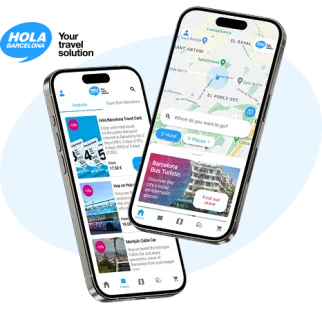Carrer de Montcada
A stroll on old Barcelona’s most majestic medieval street
Its Gothic, Catalan Renaissance and even baroque palaces make this street the city’s most important civil architecture site. The bourgeois street par excellence in the 15th and 16th centuries, Carrer de Montcada is a historical and artistic site that is home to majestic palaces converted into galleries and museums.

Barcelona Bus Turístic, on the Hola Barcelona app
Your app for visiting the city with the Barcelona Bus Turístic: routes, stops and the most iconic places. A comfortable way to carry your tickets too!
Why visit Carrer de Montcada?
Carrer de Montcada was built in the mid-12th century on land owned by the Montcada family. Areas of houses outside the city walls soon grew up around this street, given that it linked the Bòria trading district with the old Vilanova del Mar maritime district to form the Ribera district, now El Born.
Numerous palaces were built from the 14th to the 18th centuries, but the golden age of the street was in the 15th and 16th centuries, during which it was a street for high society, where aristocrats, noblemen and wealthy traders had their mansions built. These stately homes generally follow the typical Catalan Gothic model, structured around a central courtyard from which the piano nobile can be accessed by means of an arched staircase. Some of its medieval buildings have been preserved, such as Palau Aguilar, Palau Meca and Palau del Baró de Castellet, which are the sites of the Picasso Museum of Barcelona, and also some Catalan Renaissance buildings, such as the Palau dels Cervelló, and baroque buildings, like the Palau Dalmases.
The street’s decline started in the 18th century, coinciding with the creation of the Born market and the use of some houses and minor palaces as warehouses, and it was accentuated during the second half of the 19th century, when many of its well-to-do families left to live in the new Eixample district designed by Cerdà.
The street was declared a historical and artistic site of national interest in 1947 and is now considered to be Barcelona’s richest medieval architecture site. Most of the palaces have become museums or art galleries, such as the five occupied by the aforementioned Picasso Museum; Palau Nadal and the Palau del Marquès de Llió, which are the home of the Museum of World Cultures of Barcelona; and the Palau dels Cervelló, where the Fundació Gaspar art gallery is located.
How do you get to Carrer de Montcada?
On the Red Route of Barcelona Bus Turístic you can get to Carrer de Montcada from the Pla de Palau – Parc de la Ciutadella stop or from the Barri Gòtic stop.
For the most curious of you
- Did you know? The street was widened at both ends, according to chronicles from the period, to enable Corpus Christi processions to access it and turn around, which shows how important the people who lived on the street were.
- Local’s tip: If you carry on along Carrer de Montcada, after crossing Carrer de la Princesa you will reach a small square where the Chapel of Marcús is located. It is a Romanesque chapel from the 12th century that was named after its benefactor Bernat Marcús.
- A must: For lovers of Catalan Gothic architecture and Barcelona’s medieval past.








